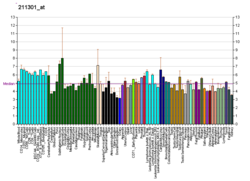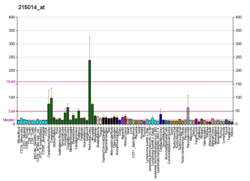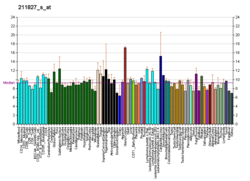Potassium voltage-gated channel subfamily D member 3 also known as Kv4.3 is a protein that in humans is encoded by the KCND3 gene.[5][6][7] It contributes to the cardiac transient outward potassium current (Ito1), the main contributing current to the repolarizing phase 1 of the cardiac action potential.[8]
- ^ a b c GRCh38: Ensembl release 89: ENSG00000171385 – Ensembl, May 2017
- ^ a b c GRCm38: Ensembl release 89: ENSMUSG00000040896 – Ensembl, May 2017
- ^ "Human PubMed Reference:". National Center for Biotechnology Information, U.S. National Library of Medicine.
- ^ "Mouse PubMed Reference:". National Center for Biotechnology Information, U.S. National Library of Medicine.
- ^ Postma AV, Bezzina CR, de Vries JF, Wilde AA, Moorman AF, Mannens MM (Aug 2000). "Genomic organisation and chromosomal localisation of two members of the KCND ion channel family, KCND2 and KCND3". Hum Genet. 106 (6): 614–9. doi:10.1007/s004390050033. PMID 10942109.
- ^ Gutman GA, Chandy KG, Grissmer S, Lazdunski M, McKinnon D, Pardo LA, Robertson GA, Rudy B, Sanguinetti MC, Stuhmer W, Wang X (Dec 2005). "International Union of Pharmacology. LIII. Nomenclature and molecular relationships of voltage-gated potassium channels". Pharmacol Rev. 57 (4): 473–508. doi:10.1124/pr.57.4.10. PMID 16382104. S2CID 219195192.
- ^ Cite error: The named reference
entrezwas invoked but never defined (see the help page). - ^ Oudit GY, Kassiri Z, Sah R, Ramirez RJ, Zobel C, Backx PH (May 2001). "The molecular physiology of the cardiac transient outward potassium current (I(to)) in normal and diseased myocardium". J. Mol. Cell. Cardiol. 33 (5): 851–72. doi:10.1006/jmcc.2001.1376. PMID 11343410.







